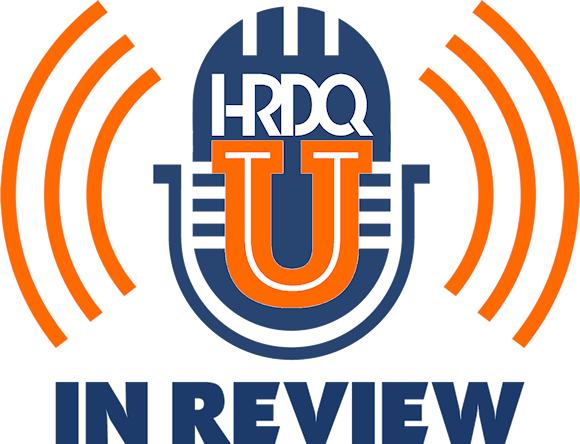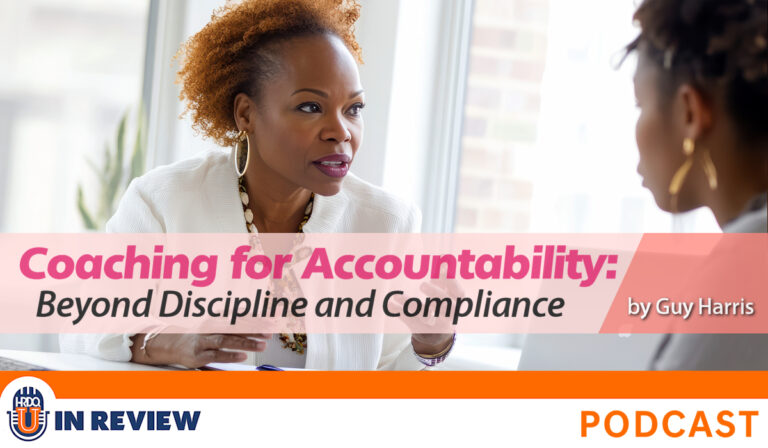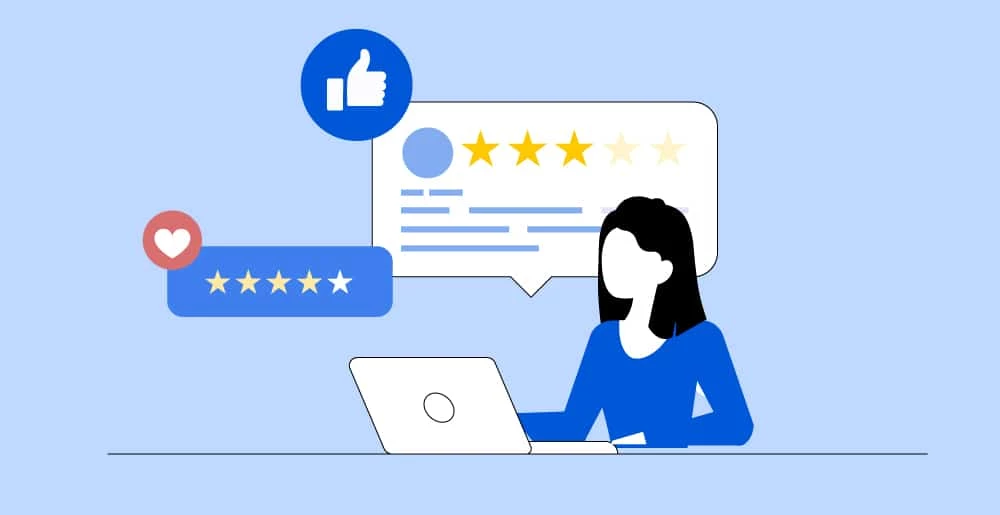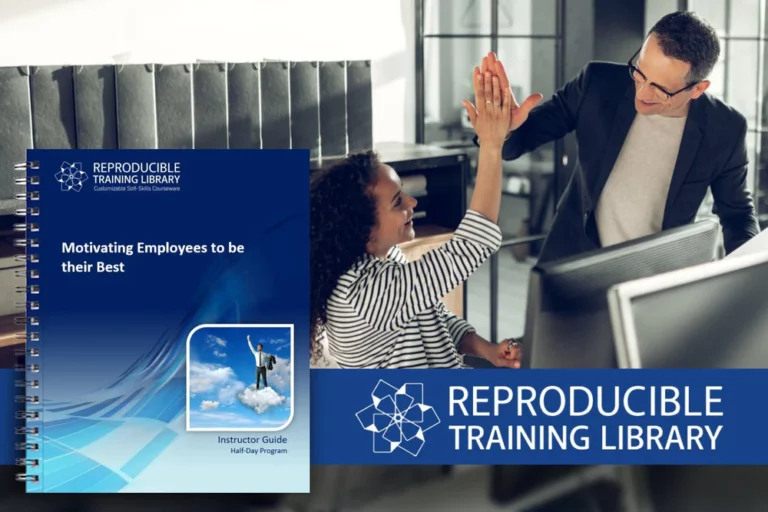

In this episode of HRDQ-U In Review, host Sarah sits down with leadership expert Guy Harris to explore coaching for accountability beyond discipline and compliance.
Guy shares his journey from chemical engineering and naval nuclear service to a 24-year career in leadership development, focusing on conflict resolution, communication skills, and coaching new frontline leaders. Together, Sarah and Guy dive into the challenges leaders face with negativity bias – why we often notice what’s going wrong before what’s going right – and how shifting to a positive, future-focused coaching approach can create more accountable, high-performing teams.
This conversation is full of practical tools and quick wins, from recognizing and reinforcing positive behaviors to building coaching strategies that inspire growth and engagement. Guy emphasizes that effective coaching goes beyond correcting mistakes – it encourages behaviors that drive success and fosters stronger team dynamics.
Whether you’re a manager, team leader, or aspiring coach, this episode will help you guide your team toward accountability and performance without relying on discipline alone.
Chapters
Action Items for Listeners
00:02
Welcome to this week’s episode of the HRDQ-U In Review podcast, where we bring you the latest insights and practical tools for enhancing soft skills training in your organization. This podcast is brought to you by HRDQU.com, and I’m your host, Sarah, Learning Events Manager here at HRDQ-U. And today we are joined by Guy Harris to discuss the webinar, Coaching for Accountability: Beyond Discipline and Compliance. Now, before we dive in here, be sure to subscribe to our newsletter at HRDQU.com for exclusive updates and upcoming webinars.
00:31
as well as resources to help you and your team excel. Also give us a follow on, leave us a review on whatever platform that you listen to your podcast. allows us to continue to produce this content to a weekly here. And Guy, welcome. Thanks so much for joining me today. First time on the podcast. Yeah, glad to be here. Thanks Sarah. So could you start off here by just sharing a little bit about yourself and the work that you do?
00:55
Sure. So my background starts with chemical engineering, undergraduate and graduate degrees, service in the Navy as a nuclear engineer. So I spent a lot of time in a really technical kind of world. Early in my career, made the realization that all the technical training didn’t teach me a lot about working with people. And that was a big part of what I had to do. So then I went on this journey to learn how to work with people better. And it turned into a coaching and training, like teaching other people what I had learned. And I’ve been doing that for, ooh.
01:25
24 years now out of the engineering world into the leadership and development world. My focus areas are conflict resolution, communication skills, coaching skills, those kind of things, primarily focused on new leader, new front line leader development, that kind of thing. I work with a Kevin Eikenberry group out of Indianapolis, even though I’m physically in South Carolina. Great. Well, thanks for sharing. And for our listeners who have yet to see the webinar, can you walk us through the key takeaways that you leaders to remember?
01:54
Yeah, the key ideas are to remember that all of us have what’s known as a negativity bias and that we notice what people don’t do right before we notice what they do right. And as a result of that, we’ll get really fixated on that. And as we start to engage with people about improving performance, we default into a like eliminate the bad approach to coaching, which has some limited effectiveness.
02:23
It’s just that the thing I’d like to recommend to people is to focus more on finding what people do well, encourage them to do more of that rather than focus on what they do poorly and try to get them to do less of that. And so it’s really a shift to let’s talk about the future and what’s good and better rather than the past and what went wrong and try to find ways to.
02:50
rather than eliminate bad behaviors, try to encourage good behavior. So it’s a little different shift in the way we focus on things. And the key is like, I have to remind myself this too, we are all biased towards focusing on the negative. It takes effort and intentionality to shift that focus to, well, let’s focus on the good things we would like to see rather than eliminating the bad things. Now, as we dive deeper into the content here, can we start off by…
03:17
Can you define the core difference between discipline and compliance versus accountability and coaching and leadership? Yeah, well, the big difference really comes down to what is the motivational factor. So when we rely on discipline and trying to get people to comply with our wishes, are, whether we mean to or not, we’re actually leaning on a fear-based motivation. And there’s plenty of research that says there actually is some place for that. So I’m not going to suggest that that’s never part of our repertoire.
03:48
It’s just that fear and uh trying to avoid punishment tends to create for people a do just enough to not get in trouble kind of motivation rather than a commitment to excellence and grow and develop type of motivation. So the difference is that discipline and compliance focuses on fear and avoiding pain, whereas shifting towards creating a feeling of accountability and coaching for excellence is appealing to
04:16
a desire to excel. It’s appealing to more of an internal motivator so that people bring their creativity and commitment to work rather than, well, I just don’t want to get in trouble kind of drivers. So then when would you say it’s better for a leader to choose coaching over discipline and what impact does that choice have on team performance? As a general rule, I’d say coach more than your discipline. That’s kind of a general rule. And I think actually if you pay attention to what most people do,
04:45
or what most employees bring to work, most people actually want to do a good job. And so if you can appeal to that, then you create a more positive environment, a more creative environment, more committed environment. generally speaking, as long as we’re working with people who are not at risk of getting fired, maybe they have some behaviors that aren’t ideal, they’re not perfect, they’re not excellent, but you wouldn’t think about firing them for it.
05:12
As long as they’re in that kind of range where they’re not really at risk of losing their job, coach rather than discipline and avoid the tendency to unintentionally discipline when what you meant to do was coach. So what can leaders then do to strengthen their relationships so that feedback has a greater impact as they’re connecting with their employees? Well, part of the idea here in terms of trying to coach for accountability rather than discipline for compliance is that as a leader,
05:42
It’s important to know what the motivators are for the members of your team. What are the things that they’re inspired by? What are the things they like to do, don’t like to do? um What is it that actually drives them? And one of the things to do there is, as you indicated, build a relationship with them. Part of that involves know what they do when they’re not at work. What are their hobbies? What’s really an important thing to them? Because whether it’s important to you or not,
06:11
It is important to them. And so when we appeal to the things that are important to people, then that inspires them to perform at higher level. So building a relationship is all about knowing the pieces of the person’s life that don’t have anything to do with work. Work, yeah, it’s important. The reality is people bring their not-work self to work. And so their hobbies, their family, or lack of family, or close friends, or social engagements, or…
06:39
Whatever it is they do when they’re not at work, that’s a really big window into what drives them. So if you know those things, then you demonstrate care for the person because you’ve demonstrated the desire to know them more than just in the workplace. And that tends to start growing a relationship with them. So having interest in someone as a person, not just an employee. Yes, really know them as a human being and realize that there’s more to them than just the task they fulfill at work.
07:07
So could you share an example of how to use positive feed forward effectively? So positive feed forward, really the idea is, and we have different ways we can provide feedback comments. We can talk about what they did wrong in the past or what they did right in the past. That’s feedback, positive or negative feedback. We can talk about what they did, what we want to see in the future. We can talk about that in either positive or negative way, negative or positive. And the idea for positive feed forward is to frame our engagement with people around uh
07:37
coaching, performance management, performance discussions, results discussions, goal setting, all those kinds of related conversations around what we want to see in the future and driving our conversation in that direction. So it’s a very future focused and positive kind of engagement. When people are doing things great and you’re happy with them, that is very easy because well, everything’s going great. So you’re not frustrated when it’s hard.
08:05
is when something hasn’t gone quite right and what you’re trying to do is steer them in a more positive direction. This is where because of our negativity bias, most of us will default towards negative feedback, which would be any kind of statement that says, the thing you did or the result you got, don’t do that again.
08:26
Easy to do, very natural. It starts drifting in the direction of compliance based conversation. Shifting that to positive feed forward would be to do the hard work. it’s like, we will notice what somebody did wrong. Like they were late with a report or they didn’t achieve a result we wanted to see, or they did something well intentioned that just didn’t turn out well or any kind of thing like that. So you see it as a supervisor, you’re really frustrated by it.
08:55
The idea of positive feed forward would be to have a conversation with the person. Ideally, it would be more question than statement. it’d be something like, um so like say you were on my team, Sarah, it’d be something along these lines. Hey, Sarah, that report that came in yesterday, do you have any observations about that? Or do you have any, uh do you have a perspective about was that what we’re looking for and not looking for? Or how do you feel about that report? How you got here kind of depends on how you asked the question.
09:23
know what the specific situation was. Let’s say you put in a report and it was a day late. hey, Sarah, are you aware that that report you gave me yesterday was later than it was supposed to be? And you’d probably say, yeah, yeah, I kind of feel bad about that. So yeah, yeah, understand. Hey, so Sarah, what is it that got in the way of getting the report in on time? So I’m going start investigating with you what got in your way. We’ll talk about that a little bit. And then we’ll shift it to um
09:52
So what could we do in the future so that we don’t wind up being late again? What do we do differently the next time? So I’m trying to steer the conversation in a direction with questions and hopefully with gentle tones and body language and all that to steer the conversation so that you identify what needs to be done differently the next time rather than me tell you what needs to be done next time. And then the final wrap up of that with the, what I would call the positive feed for part of this. So Sarah, you know, we talked about this, you think maybe in the future we could do that?
10:22
on our next time around with the Scanner Report. So I’m steering it hopefully in a positive direction. And I mean, you’re a capable person, right? You want to do a good job. You just messed up. Only telling you you messed up probably doesn’t help you want to bring your best game to work. um Because you know you messed up. What I’d rather do is try to find a way to encourage you to do something different the next time. So still setting those expectations. Absolutely. Yeah.
10:51
And so I guess that’ll lead me here to my next question for you. What’s the most reliable way for leaders to make sure their team truly understands expectations that have been set for them? The best way I found is lots of questions. um Beware of assumptions. Beware of the tendency to think, think or say things like, well, they should already know that. Or, well, I’ve told them once, well, I sent an email. I told them once.
11:19
The truth is that most human beings don’t pick up a message the first time they’ve heard it. That’s just not how it works. We tend to have to repeat things. We tend to have to say things over and over again, remind people. And rather than get frustrated about it, realize that, hey, that’s just how it works. So the way I want to make sure we’re clear is to invite feedback from people in this way, asking them things like, so…
11:48
So here’s where we’re headed. What’s your understanding of what we’re trying to achieve in the next month? Rather than me tell you, here’s what you need to do. Where are we headed with this, What’s the next step in this process? What’s your understanding of what our goals are for this year? So I’m going to try to invite people to tell me their understanding. Because if they say it to me, well, then clearly they understand.
12:14
And if they tell me something different from what I expect, now I realize there was a miscommunication and we can clarify it. So you tell me something’s totally different from what I expect. say, you know, I could, then I would, my bias, admittedly it’s my bias, I prefer to assume that if the person I’m working with doesn’t understand something, it’s my fault. And it doesn’t really have anything to do with whether it actually is my fault or not. It has to do with trying to redirect my energy to something I can control.
12:43
which is my behaviors. So if it’s my fault that you don’t understand, I can fix that. If it’s your fault that don’t understand, I can’t fix that. So if there’s a misunderstanding, then I would probably try to take the pressure off and redirect with something like, you know, I appreciate that that’s what you understood. That’s not actually what I was trying to achieve. Let see if I can clarify that a little bit. Here’s what I’m trying to achieve. Then I would even follow that up with. So what did you hear me say?
13:10
and just keep trying to elicit that response until I hear the person say to me what I hope they, what I wanted them to understand out of that situation. So lots of questions, lots of listening. So now we’ve set the expectations. What are the practical steps that leaders can take to follow up consistently without slipping into micromanagement? Well, the key with micromanagement often is um it’s actually a violation of expectation on the part of the leader towards the employee.
13:39
uh When people perceive micromanagement, it often or typically comes from a situation where the team member, the employee, had one understanding or belief or expectation about when the check-in frequency would be or when the follow-up meeting would be or when the results were due or whatever might be true. And the leader violates that expectation by checking in too frequently. So like, for example, I give you a week to do something.
14:09
and I check with you at 8 a.m. tomorrow and ask you how it’s going. Well, your first thought is, well, you told me I had a week. It feels like you’re all up in my stuff. It would be different if on the front end I said to you, hey, you got to wait to get this done. The reality is I have people check in with me every day on this. So I need to stay closely connected with you on how we’re progressing. I’m gonna check in with you tomorrow morning to see how you’re getting along, see if there’s any barriers.
14:37
So now when I check in with you, it fits the expectation you have. It doesn’t feel like micromanaging. So the key to avoid micromanaging is for the leader to communicate in a way that makes sure the member of the team knows what the frequency of check-in is or knows when the results are due or whatever we’re talking about specific project timelines and sets those expectations right at the front end and then doesn’t violate them. Here’s a potential catch. Let’s say
15:06
I told you out of week, ah we had our conversation yesterday. It’s now two in the afternoon, the day after we had the conversation that I told you out of week, but somewhere in the meantime, I learned something different. So I do have to check in with you earlier than I told you I was going to. Then the way to avoid feeling like it’s micromanaging in that state, in that context, is to tell the person something has changed. So, hey, Sarah, I told you I had a week. Hey, I learned something in the meantime.
15:36
So as a result, I got to check in with you now so I can update this other person. So we’re keeping the dialogue open and it doesn’t feel so much like the leader is just checking up on the person. And if there’s one key message that you hope listeners take away from this conversation, what would it be? I think the key message is to be aware of negativity bias and to focus more on the future and positive than on the past negative. That’s the big idea. uh
16:06
All the other stuff kind of flows out of that. They become applications of that core idea. lastly, Guy, where can listeners go to learn more about coaching for accountability and to connect with you and your work? I’d say start at kevinnichenberry.com. That’s Kevin I can bring group hub has access to the whole Kevin I can bring team and all the events and different things we’re doing blogs, YouTube channels, all that stuff. That’s the hub.
16:32
And if they’d to plug into an event that we have coming up later this month, it’s called Virtual LeaderCon. It’s September 22nd to the 25th. It’s free. And people can learn more about that at virtualleadercon.com. Well, thank you, Guy, for your time today. Thanks, Sarah. It’s good to see you be with you.
16:51
And if you have yet to check out the webinar, we will have all that information linked down below. I highly recommend you do so. We hope you enjoy listening to the HRDQ-U In Review podcast, available on all major streaming platforms. If you did enjoy today’s episode, make sure to give us a follow and leave us a five-star review. Thank you all for tuning in to this week’s episode of the HRDQ-U In Review podcast, brought to you by HRDQU.com.


Listen to this podcast event at no charge with your
HRDQ-U Free Access Membership
In this episode of HRDQ-U In Review, host Sarah sits down with leadership expert Guy Harris to explore coaching for accountability beyond discipline and compliance.
Guy shares his journey from chemical engineering and naval nuclear service to a 24-year career in leadership development, focusing on conflict resolution, communication skills, and coaching new frontline leaders. Together, Sarah and Guy dive into the challenges leaders face with negativity bias – why we often notice what’s going wrong before what’s going right – and how shifting to a positive, future-focused coaching approach can create more accountable, high-performing teams.
This conversation is full of practical tools and quick wins, from recognizing and reinforcing positive behaviors to building coaching strategies that inspire growth and engagement. Guy emphasizes that effective coaching goes beyond correcting mistakes – it encourages behaviors that drive success and fosters stronger team dynamics.
Whether you’re a manager, team leader, or aspiring coach, this episode will help you guide your team toward accountability and performance without relying on discipline alone.
Chapters
Action Items for Listeners
[ PODCAST PLAYBACK ]
You must be signed-in with your membership account to access this content.
Enjoyed this podcast? Have suggestions on how we can improve? Please take our quick survey and receive a coupon for 15% OFF any of our individual membership plans.

*Instant 15% coupon available upon completion of survey.
Want to learn more? Become an Individual or Corporate member to watch this and hundreds more webinars!
Find out how coaching for accountability can elevate your performance. Stay accountable and make real progress towards your ambitions.

Guy Harris
Guy Harris consults, coaches, and trains on team and interaction dynamics, communication strategies, and emotional intelligence. Prior to becoming a trainer and coach, he served as a Nuclear Engineering Officer in the U.S. Navy Submarine Force and in leadership positions in business.
Guy focuses on practical application of human behavior and motivation principles. Using his unique skillset, he helps clients work through the human factors that often limit rapid implementation and results to quickly achieve the technical and task accomplishment necessities of business operations.
Some typical client concerns prior to working with Guy have been building a high-performing team, resolving workplace conflicts, developing leaders, expanding personal influence, communicating more effectively, and developing buy-in for new programs and processes.
He co-authored From Bud to Boss: Secrets to a Successful Transition to Remarkable Leadership with Kevin Eikenberry. He also hosts the Talk Like a Leader Podcast.
Guy holds bachelor’s and master’s degrees in chemical engineering. He was an Engineering Department head in the U.S. Navy. He is a Master Trainer and Coach in the DISC Model of Human Behavior, and a Workplace Conflict Resolution Expert.

Training Tools for Developing Great People Skills
This event is sponsored by HRDQ. For over 45 years HRDQ has provided research-based, off-the-shelf soft-skills training resources for classroom, virtual, and online training. From assessments and workshops to experiential hands-on games, HRDQ helps organizations improve performance, increase job satisfaction, and more.

Motivating Employees to be their Best Customizable Courseware
When your team’s energy fades, reminders aren’t enough – you need actionable strategies. Discover how to eliminate obstacles, ignite intrinsic motivation, and foster a culture where employees feel empowered.
Buy at HRDQstore.com
The Accountability Experience
Ready to elevate your team’s collaboration? Equip your employees with the skills and tools to take ownership, keep commitments, and build trust to drive higher engagement, clearer expectations, and better results with less conflict and stress.
Buy at HRDQstore.comThe HRDQ-U In Review Podcast, brought to you by HRDQU.com, brings you the latest insights and practical tools for enhancing soft-skills training in your organization. As a learning community for trainers, coaches, consultants, managers, and anyone passionate about performance improvement, we interview subject matter experts and thought leaders from recent webinars they presented with us to take a deeper dive into the content they shared and answer all your questions. Join us as we explore new ideas and industry trends, share success stories, and discuss challenges faced by professionals.
The HRDQ-U In Review Podcast is intended for HR and training professionals, organizational development practitioners, and anyone interested in improving workplace performance and productivity.
New episodes of HRDQ-U In Review are released every week.
The length of the episodes varies, but they typically range from 15-30 minutes.
The podcast covers a wide range of topics related to HR and organizational development, including leadership development, team building, communication skills, conflict resolution, employee engagement, and more.
No, HRDQ-U In Review is completely free to listen to.
You can listen to any available HRDQ-U In Review Podcast right on our website at HRDQU.com via our embedded Spotify player on the related webinar page. In addition to our self-hosted option, you can find the HRDQ-U In Review Podcast on many of the popular streaming services, which are listed above.

Download our catalog of our top 20 most popular webinars.